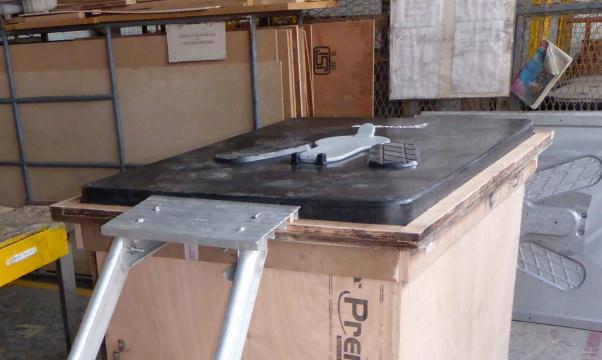Why should latrine slabs come from far away while the local economy suffers?
At present many emergency sanitation projects use imported latrine slabs. At the same time the economy in countries likely to be affected by disasters is often weak.
Cost effective latrine slab produced locally
Ideally latrine slabs used in countries affected by disasters would be produced locally. In this way the local economy can enjoy the benefits.
Objective:
To stimulate the Regional and local market in production of latrine slabs.
Activities undertaken
Feasibility study of different manufactures who have the technical competencies and capacity to produce latrines slabs locally has been completed.
Prepare design and mould.
During joint discussions between WASTE and Oxfam GB it was strongly suggested to use the design of the KK Nag slab, that is now becoming a recognized standard and not start a new design process all over again. The cost of tooling and moulds are prohibitive for new plastic products: € 10,000 – 20,000 for roto-moulding and upto € 100,000 for injection moulds.
Identify production capacity and pilot country & Inventory plastic producers.
Intensive interactions were held with Kentainer in Kenya. However, Oxfam has tried to use Kentainer slabs in the past and found them unsuitable for use in rapid emergency situations, mainly due to their size and weight and the squat hole cover. Kentainer was not willing to modify its slab design. So the issue was left aside, as agencies responding to emergencies are unlikely to buy it.
Discussions were also held with ARKAY plastics in Malawi. As the funds for an injection mould are outside the scope of ESP, WASTE has teamed up with ARKAY plastics in the framework of the UNICEF/DFID Challenge fund in Malawi. However, the funding did not materialize.

Inventory feasibility recycled plastic.
Our study on the feasibility of recycled plastic for squatting slab use revealed that it is an easy thing to do. However, according to KK Nag, the colour has to be black, which is less attractive as it might attract flies. As black tends to become hotter, the plastic might become a bit ‘brittle’. KK Nag produces these slabs on the request of Unicef. See picture below.
Nag Magic slab out our recycled plastic
Production and product testing
The overall conclusion of the ESP is that this topic could be taken up by the market and there are many alternatives. There is little additional value to put extra ESP resources in this topic.
Tell us your idea!
If you have any products, a product facility, ideas or would like to become involved in the local production of latrine slabs, please get in touch with:
Jan Spit, Adviser Sanitation
WASTE advisers on urban environment and development
www.waste.nl
e-mail: jspit@waste.nl
tel: + 31 182 52 26 25
mob: +31 6 57 99 78 74